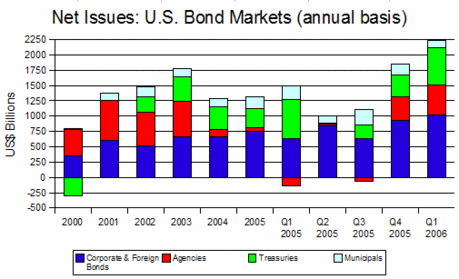Record Bond Issues Push Rates Higher: Q1 2006
by John Schroy filed under Treasuries, Open Market, Agencies, Mortgages, Municipals, Corporate Bonds
Net issuance of bonds into the U.S. market in Q1 2006 surpassed prior records, forcing bond prices to fall and rates to rise.
Total, annualized net sales for corporate and foreign bonds, agencies, treasuries and municipal bonds reached $2.2 trillion, 70% higher than bond issuance in 2005.
There are several reasons for this record level of bond issuance:
Issuance of Treasury bonds, which seems to be seasonal, was running higher in the first quarter of the year;
Issuance of agency bonds, which had fallen sharply after the accounting scandals at Fannie Mae in 2004, was now returning to normal levels;
Bonds issued by domestic corporations were at record levels, primarily because of the desire to raise money to pay for stock repurchases.
 Net Issuance: US Bond Markets
|
||


